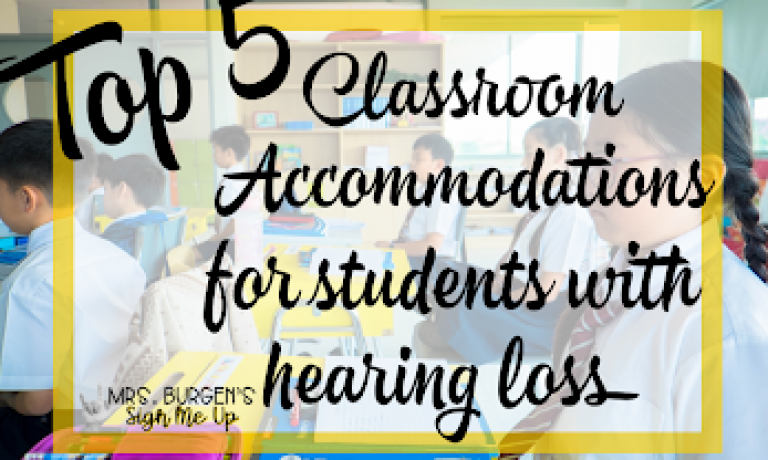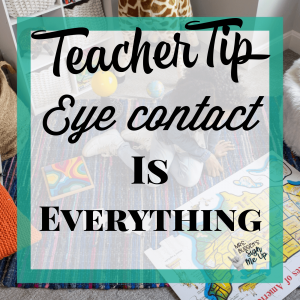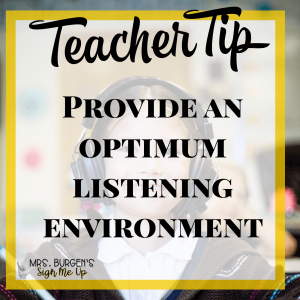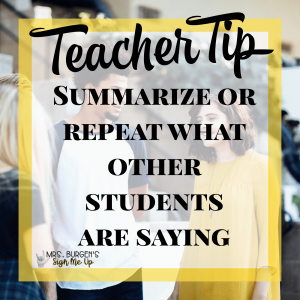
So you have a student in your class with a hearing loss. He or she may use assistive hearing technology such as hearing aids, cochlear implants or a Bone Anchored Hearing Aid (BAHA) to gain access to communication in the classroom. What can you do to set up your student for success?
HOW CAN I BE SURE MY STUDENT HAS THE BEST ACCESS TO COMMUNICATION IN THE CLASSROOM?
It’s really all about ACCESS.
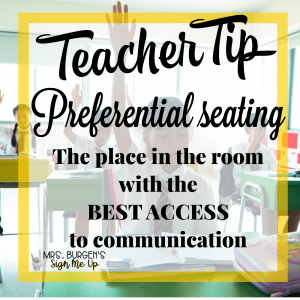
TEACHER TIP #1
Preferential seating
The place in the classroom where the student has the best access to communication.
Communication comes in many forms, typically we think of how the student can access the teacher’s voice and instruction, but communication in a classroom is so much more than that. Is the student in a place where they can see the other students who are speaking and responding to whole group questions. Are they able to have eye contact with the speaker as well as any visuals that are being used. (smart board, charts, demonstrations) So, preferential seating is not always just front and center of the classroom, work with the student to find a place where they feel they are able to get the best access to all communication in the classroom.
TEACHER TIP #2
Eye Contact is Everything
When working one on one with a student, place yourself in front of the student and make eye contact to check for understanding.
Teachers tend to kneel, stand or sit next to a students to work with them. However, for a student with a hearing loss, eye contact is everything. Your student will get the best out of the instruction if they are able to see you when you are speaking. This means letting students look at your face while you are talking and then look down at the paper, book etc, then back up at you. (as opposed to talking while pointing at the same time) This is also a great way for you to check for understanding and allow the student to confirm with you what was said.
Teacher Tip #3
Provide an optimum listening environment
Provide the best learning environment possible by minimizing ambient noises.
Classrooms are noisy, I get it. They should be noisy. Learning requires a lot of discussion and interactions, but that’s not what I’m talking about here. Many other things make noise in a classroom as well, the heater, a/c unit, fans, projectors, tile floors, children whispering, tapping, chewing etc. Even the noise from outside the classroom in the hallways or traffic outside the windows can be very noisy. Hearing aids, amplify ALL SOUND, and even with the best programing, the background noise can be very distracting. When setting up your room and creating optimum space for your student with hearing loss, do your best to avoid ambient sounds, close the door, and avoid seating that is under a projector or near a fan or heater.
Teacher Tip #4
Use an FM system
Amplify your voice and the other student’s voices with an FM system.
As I mentioned earlier, Hearing Aids amplify all sound and the optimum distance for listening with hearing aids is 3-6 feet. How often are you giving instruction within 3 feet of your student? Ideally you want your voice to be elevated above all other sounds in the classroom. This gives your student the best access to your voice no matter where you are in the room. Likewise, you want your student with hearing loss to have access to the other student’s voices as well. This is especially important during class discussions, or when other students are reading aloud. If you have the option, pass the microphone around the room to students who are speaking so the student with hearing loss has access to what everyone in the classroom is saying.
Teacher Tip #5
Repeat or summarize important information shared by students during whole group discussions
In the case where you are not able to provide amplification to student voices, be aware that it is likely that your student (and often many other students) did not hear what was said. For example, while reading a story, you pose the question, what do you think will happen next? Several students raise their hands and you call on three of them to comment. What your Hard of Hearing student likely heard was only your response, so… “Good answer!” “How did you know that?” ” Class, do you agree with Mike?”. As teachers we want all the students to gain information from their peers, form opinions about whether they agree or disagree with what was said and be active participants in the discussion. Without full access to the comments of peers, the ability for students with hearing loss to be active participants in class discussions is negligible.
Take the time to say the student’s name who was commenting or asking a question and then, summarize what was said. So it might sound something like this. “Mike thinks the cat will go out the door. Sharon thinks the cat will hide under the bed, do you agree with Mike or Sharon?? Make your own prediction about what will happen next in our story. In this way the student has access to the full conversation and not only gains more information, but feels more comfortable actively participating in the discussion.
Having deaf or hard of hearing students in your class can be overwhelming at first, and there are many accommodations that can benefit students. But if you are not able to do anything else, implement these 5 things and set your students up for success!
Please feel free to share this blog post with teachers and colleagues and leave a comment about how you accommodate deaf or hard of hearing students in your classroom.

